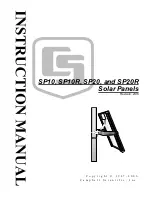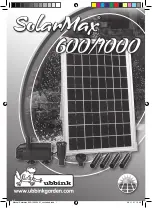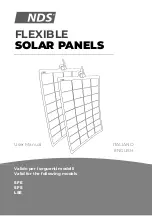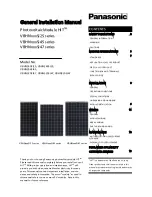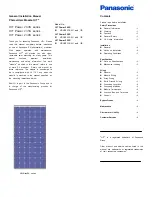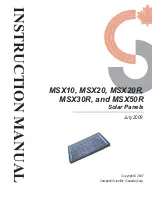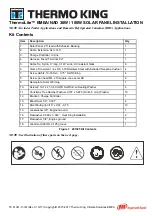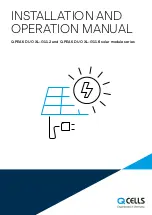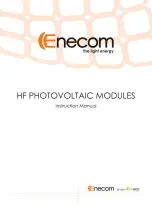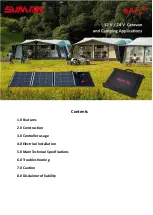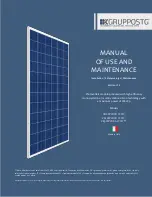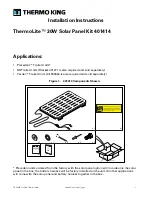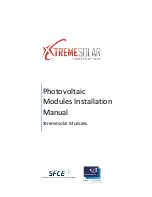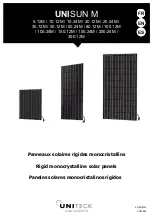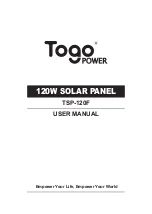
General Installation Manual
© Apr 2012, SANYO Electric Co., Ltd. All Rights Reserved
1
General Installation Manual for
Panasonic HIT
©
Double Photovoltaic
Modules, manufactured by SANYO.
Please read this manual completely
before installation or use of HIT Double
modules. This manual applies to the
following products:
HIT Double 195
(VBHB195DA03, VBHB195DA03B)
HIT Double 190
(VBHB190DA03, VBHB190DA03B)
HIT Double 186
(VBHB186DA03)
INTRODUCTION
Thank you for choosing
Panasonic
HIT
©
Double
PV modules. With proper operation
and maintenance,
Panasonic
modules will
provide you with clean, renewable solar
electricity for many years. This manual
contains important installation, maintenance
and safety information. The word “module”
as used in this manual refers to one or
more PV modules. Retain this manual for
future reference.
Disclaimer of Liability
SANYO does not assume responsibility and
expressly disclaims liability for loss,
damage, or expense arising out of, or in
any way connected with installation,
operation, use, or maintenance by using
this manual.
SANYO assumes no responsibility for any
infringement of patents or other rights of
third parties, which may result from use of
modules.
No license is granted by implication or
under any patent or patent rights. The
information in this manual is believed to be
reliable, but does not constitute an
expressed and/or implied warranty.
SANYO reserves the right to make changes
to the product, specifications, or this
manual without prior notice.
The return of any modules will not be
accepted by SANYO unless prior written
authorization has been given by SANYO.
General Information
The installation of solar modules requires a
great degree of skill and should only be
performed by qualified licensed
professionals, including, without limitation,
licensed contractors and electricians.
WARNING
All instructions should be read and
understood before attempting to install,
wire, operate, and/or maintain the
photovoltaic module. PV modules
generate DC electrical energy when
exposed to sunlight or other light
sources. Contact with electrically active
parts of the module such as terminals
can result in burns, sparks, and lethal
shock whether the module is connected
or disconnected.
The shock hazard increases as modules
are connected in parallel, producing
higher current, and as modules are
connected in series, producing higher
voltage.
The installer assumes the risk of all
personal injury or property damage that
might occur during installation and
handling of modules.
To avoid injury or damage:
•
Cover the entire front and back
surface of the bifacial modules with
a dense, opaque material such as a
cardboard box or heavy cloth.
•
Work only in dry conditions, with
dry modules and tools.
•
Do not stand or step on a module.
•
Do not drop a module.
•
Do not break the glass surfaces of a
module.
•
Do not allow children and
unauthorized persons near the
installation site or storage area of
modules.
•
Completely ground all modules
according to applicable electric
codes.
•
Do not disassemble the module, or
remove any part installed by the
manufacturer.
•
Do not open the cover of the
junction box.
•
Wear suitable protection (gloves,
clothes, etc.) to prevent direct
contact with 30V DC or greater.
•
Carry a module by its’ frame with
two or more people.
•
Do not carry a module by its wires
or junction box.
Wear non-slip
gloves.
•
Do not drop or place heavy items on
the surfaces of a module (such as
tools).
•
Check that all other system
components (inverters, wires, racks,
balance of system materials, etc.)
are mechanically and electrically
compatible.
•
Do not install the module where
flammable gases or vapors are
present.
•
Never leave a module unsupported
or unsecured.
•
Do not use or install broken
modules.
•
Do not artificially concentrate
sunlight on a module by mirror,
Fresnel lens, magnification, etc.
•
Do not touch the junction box
terminals.
•
Do not change the wiring of bypass
diodes.
•
Do not touch a PV module
unnecessarily. The glass surface
and frames get hot. There is a risk of
burn.
CAUTIONS
•
Use a module for its intended
purpose only.
•
Do not treat any portion of the
module with paint or adhesives, to
avoid damage to the module,
inoperable conditions, or reducing
the module’s functionality.
•
HIT Double modules have bifacial
performance. These modules
produce power from both surfaces
of the module at the same time and
may generate up to 30% more
output power than its’ STC rated
value. Refer to Figure 5 for these
output electrical characteristics.
•
This additional power depends upon
the level of incident light irradiance
(albedo) available to the back side of
the module, and can be increased or
decreased depending upon site
characteristics, installation design,
weather, etc.
•
Treat the back side of the module
the same as the front side and avoid
objects that directly shade the solar
cells. Refer to “Notes on
installation” section.
GENERAL SAFETY
Follow all permission, installation and
inspection requirements.
•
Before installing modules, contact the
appropriate authorities to determine
permissions, installation and inspection
requirements that apply to your site
and installation.
•
Electrically ground modules for all
systems of any voltage. If not
otherwise specified, it is recommended
that requirements of the latest National
Electrical Code (USA) or Canadian
Electric Code (Canada) or other
national or international electrical
standards be followed. Refer to “Earth
Ground Wiring” section.
•
Check applicable building codes to
ensure that the construction or
structure (roof, facade, support, etc.)
where the modules are being installed
has enough strength.
•
For modules mounted on roofs, special
construction or structures may be













